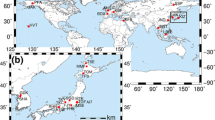Abstract
The centuries-old practice of recording plant and animal events that take place at specific times each year (phenology) should play an important role in monitoring mid-latitude global changes. At least three problems related to the detection of biosphere changes could be investigated using this information. Firstly, the technique can be generalized from the local to global scale. Secondly, an integrated approach could be developed to represent biome diversity effectively. Lastly, physical mechanisms responsible for the events can be deduced in order to incorporate the phenological information into global-scale models, and detect changes in related environmental factors. With these goals in mind, regional phenological data collection networks were initiated in eastern North America during the early 1960s, using cloned lilacs and several species of honeysuckle. This paper reviews research projects which address the problems outlined above, using first leaf data (associated with spring green-up or “green wave” in mid-latitudes) gathered from these networks. The results of such studies in North America have demonstrated the potential of phenology as an efficient monitor of global change throughout mid-latitude regions. Future research efforts will concentrate on the development of a coordinated strategy to link phenological information from satellites, indicator plants (such as the lilac), and representative species from each biome.
Similar content being viewed by others
References
Fiala, JL (1988) Lilacs, the genus Syringa. Timber Press, Portland, Oregon
Goward SN (1989) Satellite bioclimatology. J Climate 2:710–720
Hopp RJ (1978) Phenology: an aid to agricultural technology. Vermont Agricultural Experiment Station Bulletin 684, University of Vermont, Burlington
Hughes PY, Mason EH, Karl TR, Brower WA (1992) United States historical climatology network of daily temperature and precipitation data. ORNL/CDIAC-50, NDP-042, Carbon dioxide information analysis center, Oak Ridge National Lab, Oak Ridge, Tenn
Intergovernmental Panel of Climate Change (1990) Climate change: the IPCC scientific assessment. Cambridge University Press, New York
Lieth H (ed) (1974) Phenology and seasonality modeling. Springer, New York
Reed BC, Brown JF, VanderZee D, Loveland TR, Merchant JW, Ohlen DO (1994) Variability of land cover phenology in the United States. J Veget Sci (in press)
Schwartz MD (1990) Detecting the onset of spring: a possible application of phenological models. Climate Res 1:23–29
Schwartz MD (1992) Phenology and springtime surface layer change. Monthly Weather Rev 120:2570–2578
Schwartz MD, Karl TR (1990) Spring phenology: nature's experiment to detect the effect of “green-up” on surface maximum temperatures. Monthly Weather Rev 118:883–890
Schwartz MD, Marotz GA (1986) An approach to examining regional atmosphere-plant interactions with phenological data. J Biogeogr 13:551–560
Schwartz MD, Marotz GA (1988) Synoptic events and spring phenology. Phys Geogr 9:151–161
US/IBP Phenology Committee (1972) 1971–72 Annual Report of the United States/International Biological Program Phenology Committee. University of Wisconsin, Milwaukee
Author information
Authors and Affiliations
Rights and permissions
About this article
Cite this article
Schwartz, M.D. Monitoring global change with phenology: The case of the spring green wave. Int J Biometeorol 38, 18–22 (1994). https://doi.org/10.1007/BF01241799
Received:
Revised:
Accepted:
Issue Date:
DOI: https://doi.org/10.1007/BF01241799




